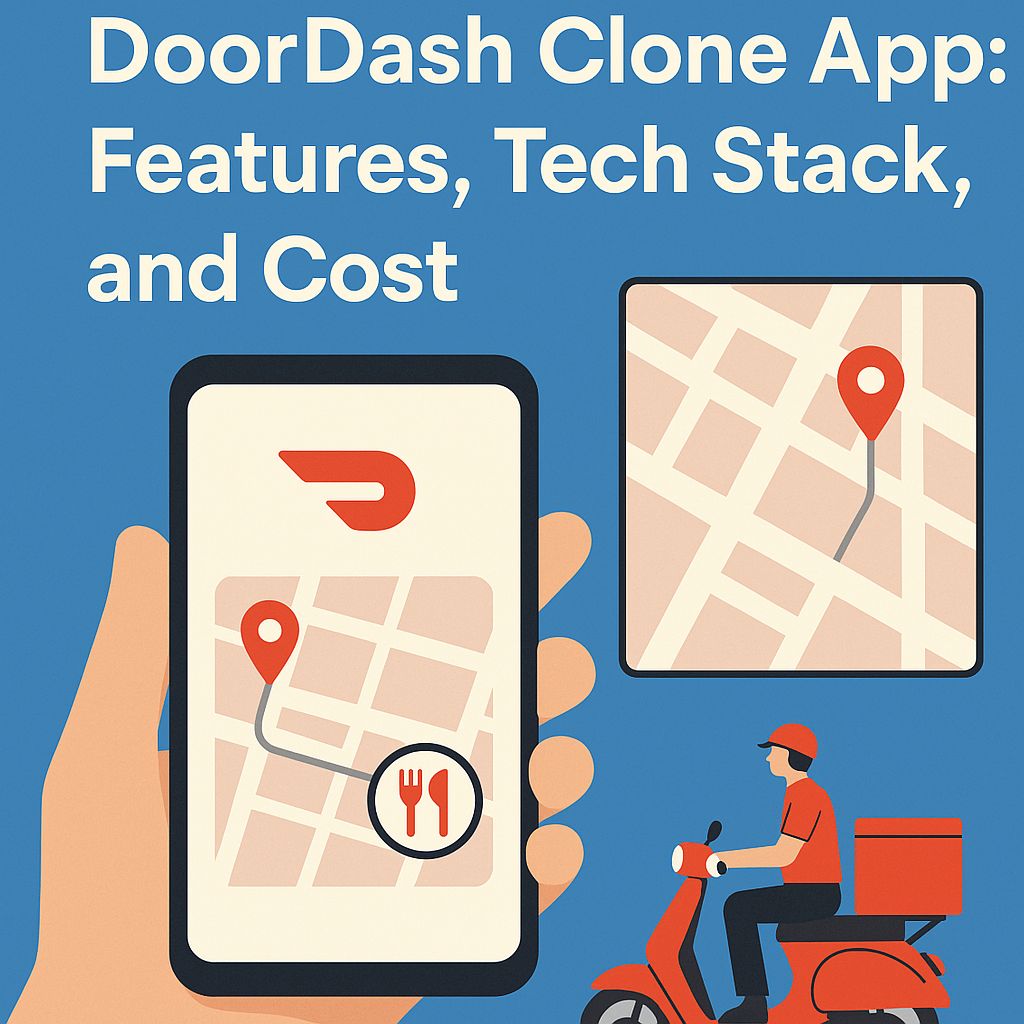In the fast-paced world of food delivery, apps like DoorDash have become an integral part of daily life, offering consumers the convenience of ordering food from their favorite restaurants with just a few taps. For entrepreneurs looking to tap into the rapidly growing on-demand food delivery market, developing a Doordash Clone app is an excellent opportunity. The rising demand for food delivery services presents a lucrative business opportunity, and with the right features, technology, and development approach, you can create a successful food delivery platform.
In this article, we’ll walk through the key aspects of Doordash Clone app development, including the essential features, the ideal tech stack, and an estimation of development costs. Let’s explore how to get started and what it takes to build a high-functioning, user-friendly food delivery app.
Understanding the Doordash Clone App Concept
A Doordash Clone app is essentially a replica of the DoorDash platform, customized to meet specific business needs or local markets. While it doesn’t mean copying DoorDash’s design and features directly, it means creating an app that offers similar services — food delivery from restaurants to customers with the convenience of mobile technology. The app consists of multiple user interfaces (for customers, restaurants, and delivery drivers), ensuring a seamless interaction between all parties involved.
By developing a Doordash Clone app, you aim to provide an intuitive solution for restaurant owners, delivery drivers, and customers. Whether you want to offer a niche market or a broader service, customizing the app can help you differentiate your business and cater to unique customer demands.
Core Features of a Doordash Clone App
A successful Doordash Clone app should incorporate several key features to ensure smooth operations and a great user experience. These features must cover the needs of all three primary users: customers, delivery drivers, and restaurant owners.
1. Customer Features
The customer interface should be user-friendly and feature-rich to ensure a pleasant experience. Some essential customer features include:
- User Registration and Login: Enable users to sign up using their email, phone number, or social media accounts.
- Search and Filter Options: Customers should be able to search for restaurants, types of cuisine, or specific dishes. Filters should allow them to sort options based on distance, price, rating, and delivery time.
- Menu Browsing: The app should display restaurant menus with images, descriptions, prices, and available discounts or deals.
- Real-Time Order Tracking: Customers need to track the status of their order in real-time, from preparation to delivery.
- Payment Integration: The app should support multiple payment methods, including credit/debit cards, wallets, and cash on delivery options.
- Ratings and Reviews: After receiving their order, customers should be able to rate the restaurant, the delivery experience, and the app.
2. Delivery Driver Features
The delivery driver interface is crucial for efficient delivery and route management. Key features include:
- Driver Registration: Drivers should be able to sign up with essential details and upload necessary documents for verification.
- Order Assignment: Delivery drivers should be notified of new orders and be able to accept or reject them based on proximity, availability, and route efficiency.
- Navigation Integration: A built-in GPS navigation system will help drivers find the most efficient route to deliver orders.
- Earnings and Payment Management: Drivers should have access to a dashboard that shows their daily earnings and payment history.
- Ratings and Feedback: Drivers should be able to rate restaurants and customers to ensure a safe and positive environment for all users.
3. Restaurant Features
The restaurant’s interface should allow efficient order management, menu customization, and customer engagement. Features to include:
- Restaurant Registration: Restaurants can register their business and upload their menu, opening hours, and other details.
- Order Management: The ability to view new orders, update the status of ongoing orders, and prepare food according to customer preferences.
- Promotions and Discounts: Restaurants should be able to create offers, promotions, and discounts to attract more customers.
- Analytics and Reporting: A comprehensive dashboard for restaurant owners to monitor sales, track customer preferences, and analyze performance.
Tech Stack for Building a Doordash Clone App
When developing a Doordash Clone app, choosing the right technology stack is essential for the success and scalability of the app. The tech stack includes the front-end and back-end technologies, databases, and tools for integration.
1. Front-End Technologies
The front-end is the part of the app that users interact with. A sleek and intuitive design is essential for providing a seamless user experience.
- Mobile App Development: Native app development using Swift (for iOS) or Kotlin/Java (for Android) is preferred for optimal performance. Alternatively, a cross-platform framework like Flutter or React Native can be used to build both iOS and Android apps simultaneously.
- Web Development: For the restaurant and admin panels, HTML5, CSS3, and JavaScript (React.js, Angular, or Vue.js) can be used to create interactive web applications.
2. Back-End Technologies
The back-end is responsible for managing app data, user accounts, and processing requests. Key technologies include:
- Programming Languages: Node.js (JavaScript), Ruby on Rails, or Python with Django are popular choices for the back-end.
- Databases: SQL databases like PostgreSQL or MySQL work well for structured data, while NoSQL databases like MongoDB can be used for more flexible data storage.
- Cloud Platforms: AWS, Google Cloud, or Microsoft Azure provide reliable and scalable cloud services for hosting your app.
3. Real-Time Features and GPS
- Real-Time Tracking: To implement real-time order tracking, technologies like WebSockets or Firebase can be used.
- GPS Integration: For navigation, integrating APIs like Google Maps, Mapbox, or OpenStreetMap will allow users to track deliveries and find nearby restaurants.
4. Payment Gateway Integration
For handling payments securely, you can integrate payment systems like Stripe, PayPal, or Razorpay into your Doordash Clone app.
Cost of Developing a Doordash Clone App
The cost of developing a Doordash Clone app depends on several factors, including the complexity of features, design, and the technology stack you choose. The average cost for food delivery app development like DoorDash ranges from $20,000 to $100,000 or more, depending on the scale and functionality.
Factors Influencing the Cost:
- Platform: Whether you are developing for iOS, Android, or both (native or cross-platform).
- Design: Custom UI/UX design will cost more than using templates.
- Features: Advanced features like AI-based recommendations, real-time GPS tracking, or chatbots will increase development time and costs.
- Location: Development costs vary by region, with companies in North America and Western Europe typically charging more than those in Eastern Europe or Asia.
Ongoing Maintenance Costs
After the app is developed and launched, ongoing maintenance, updates, and server costs will need to be considered. This can cost around 15%-20% of the initial development cost annually.
Conclusion
Developing a Doordash Clone app presents a great opportunity for entrepreneurs to tap into the booming food delivery industry. By incorporating essential features, using the right tech stack, and carefully considering the cost, you can create an app that provides an exceptional experience for customers, delivery drivers, and restaurant owners. Whether you’re aiming to build a platform for a specific niche or a broader market, focusing on quality and usability will be key to your success in the competitive world of food delivery app development.

